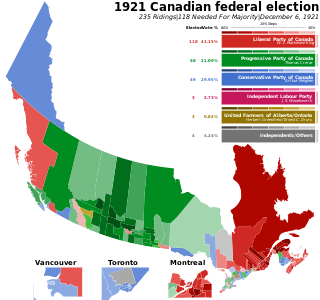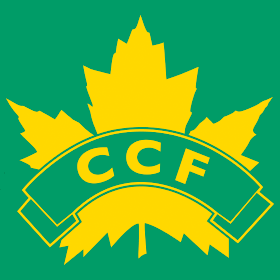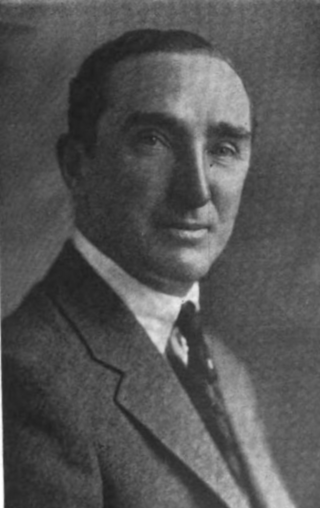The Progressive Party of Canada, formally the National Progressive Party, was a federal-level political party in Canada in the 1920s until 1930. It was linked with the provincial United Farmers parties in several provinces, and it spawned the Progressive Party of Saskatchewan, and the Progressive Party of Manitoba, which formed the government of that province. The Progressive Party was part of the farmers' political movement that included federal and provincial Progressive and United Farmers' parties.

The 1921 Canadian federal election was held on December 6, 1921, to elect members of the House of Commons of Canada of the 14th Parliament of Canada. The Union government that had governed Canada through the First World War was defeated, and replaced by a Liberal government under the young leader William Lyon Mackenzie King. A new third party, the Progressive Party, won the second most seats in the election.
There have been various groups in Canada that have nominated candidates under the label Labour Party or Independent Labour Party, or other variations from the 1870s until the 1960s. These were usually local or provincial groups using the Labour Party or Independent Labour Party name, backed by local labour councils made up of many union locals in a particular city, or individual trade unions. There was an attempt to create a national Canadian Labour Party in the late 1910s and in the 1920s, but these were only partly successful.

Harry Corwin Nixon was a Canadian politician and briefly the 13th premier of Ontario in 1943. He is both the longest-serving member in the history of the Ontario legislature and the shortest-serving premier of Ontario.
The United Farmers of Ontario (UFO) was an agrarian and populist provincial political party in Ontario, Canada. It was the Ontario provincial branch of the United Farmers movement of the early part of the 20th century.

Farquhar Robert Oliver was a politician in Ontario, Canada.
Liberal-Progressive was a label used by a number of candidates in Canadian elections between 1925 and 1953. In federal and Ontario politics there was no Liberal-Progressive Party, as such. The term generally referred to candidates endorsed by Liberal and Progressive constituency associations or to individual candidates who claimed the label, sometimes running against a straight Liberal or straight Progressive candidate. In Manitoba, a party existed with this name provincially, and Liberal-Progressives ran federally in Manitoba under the leadership of Robert Forke, with the support of the Liberal Party.
The Liberal–Labour banner has been used several times by candidates in Canadian elections:

In the Legislative Assembly of Ontario, the leader of the Official Opposition is the leader of the largest political party not in government and typically the second-largest party. The position is referred more formally as the leader of His Majesty's Loyal Opposition ; under the Westminster system, while the parliamentary opposition opposes the incumbent government, it remains loyal to the Crown and thus to Canada.

The Co-operative Commonwealth Federation – The Farmer-Labor Party of Ontario, more commonly known as the Ontario CCF, was a democratic socialist provincial political party in Ontario that existed from 1932 to 1961. It was the provincial wing of the federal Co-operative Commonwealth Federation (CCF). The party had no leader in the beginning, and was governed by a provincial council and executive. The party's first Member of the Legislative Assembly (MLA) was elected by voters in the 1934 Ontario general election. In the 1937 general election, no CCF members were elected to the Ontario Legislature. In 1942, the party elected Toronto lawyer Ted Jolliffe as its first leader. He led the party to within a few seats of forming the government in the 1943 general election; instead, it formed the Official Opposition. In that election, the first two women were elected to the Ontario Legislature as CCFers: Agnes Macphail and Rae Luckock. The 1945 election was a setback, as the party lost most of its seats in the Legislature, including Jolliffe's seat. The party again became the Official Opposition after the 1948 general election, and defeated the Conservative premier George Drew in his seat, when Bill Temple unexpectedly won in the High Park constituency. The middle and late 1940s were the peak years for the Ontario CCF. After that time, its electoral performances were dismal, as it was reduced to a rump of two seats in the 1951 election, three seats in the 1955 election, and five seats in the 1959 election. Jolliffe stepped down as leader in 1953, and was replaced by Donald C. MacDonald.
The 1943 Ontario general election was held on August 4, 1943, to elect the 90 Members of the 21st Legislative Assembly of Ontario of the Province of Ontario.

The 1894 Ontario general election was the eighth general election held in the Province of Ontario, Canada. It was held on June 26, 1894, to elect the 94 Members of the 8th Legislative Assembly of Ontario ("MLAs").

The 1919 Ontario general election, held on October 20, 1919, elected 111 Members of the 15th Legislative Assembly of Ontario ("MLAs"). The United Farmers of Ontario captured the most seats but only a minority of the legislature. They joined with 11 Labour MPPs and three others to form a coalition government, ending the 14-year rule of Ontario's Conservatives. This is one of the few examples of coalition government in Canadian history.

The 1923 Ontario general election was the 16th general election held in the Province of Ontario, Canada. It was held on June 25, 1923, to elect the 111 Members of the 16th Legislative Assembly of Ontario ("MLAs").

The 1926 Ontario general election was the 17th general election held in the Province of Ontario, Canada. It was held on December 1, 1926, to elect the 112 Members of the 17th Legislative Assembly of Ontario ("MLAs").
The 1934 Ontario general election was the 19th general election held in the Province of Ontario, Canada. It was held on June 19, 1934, to elect the 19th Legislative Assembly of Ontario ("MLAs").
The 1937 Ontario general election was held on October 6, 1937, to elect the 90 Members of the 20th Legislative Assembly of Ontario ("MLAs"). It was the 20th general election held in the Province of Ontario.
The 15th Legislative Assembly of Ontario was in session from October 20, 1919, until May 10, 1923. The parliament was elected in the 1919 Ontario general election and was dissolved prior to the 1923 general election. The leading party in the chamber after the election was the United Farmers of Ontario (UFO). It formed a coalition government with 11 Labour MLAs and three Independent candidates of varying stripes.
Morrison Mann MacBride was a politician in Ontario, Canada. He was a member of the Legislative Assembly of Ontario who represented the riding of Brant South from 1919 to 1926 and the riding of Brantford from 1934 to 1938. He served in the cabinet of Mitchell Hepburn. He entered politics as a member of the Labour party. From 1934 to 1937 he served as an Independent and from 1937 to 1938 he was a member of the Liberal party.

Manning William Doherty was a farmer, businessman and politician serving as Ontario's Minister of Agriculture during the United Farmers of Ontario-Labour government of 1919 to 1923 and as leader of the Progressives in Opposition before leaving provincial politics.